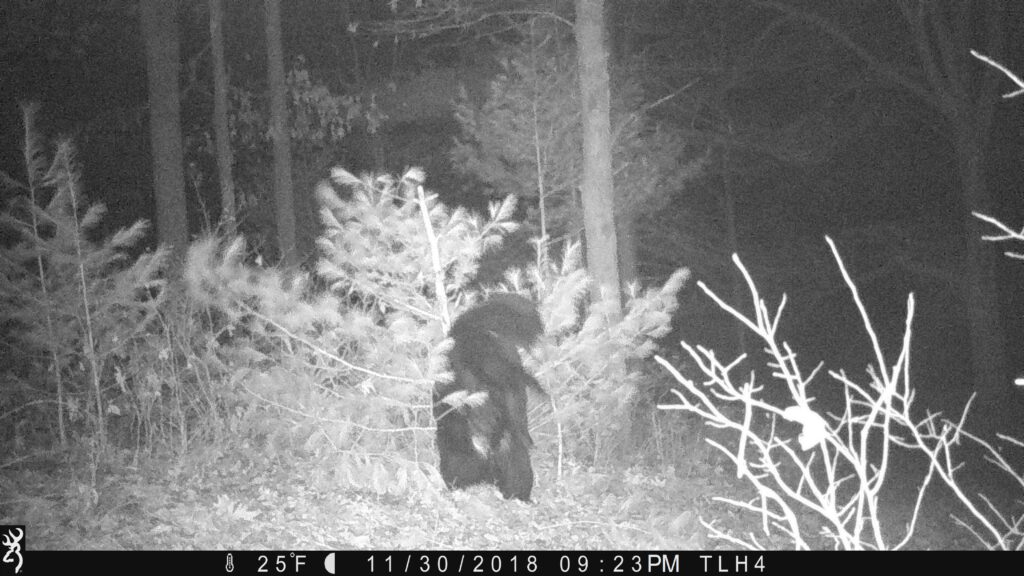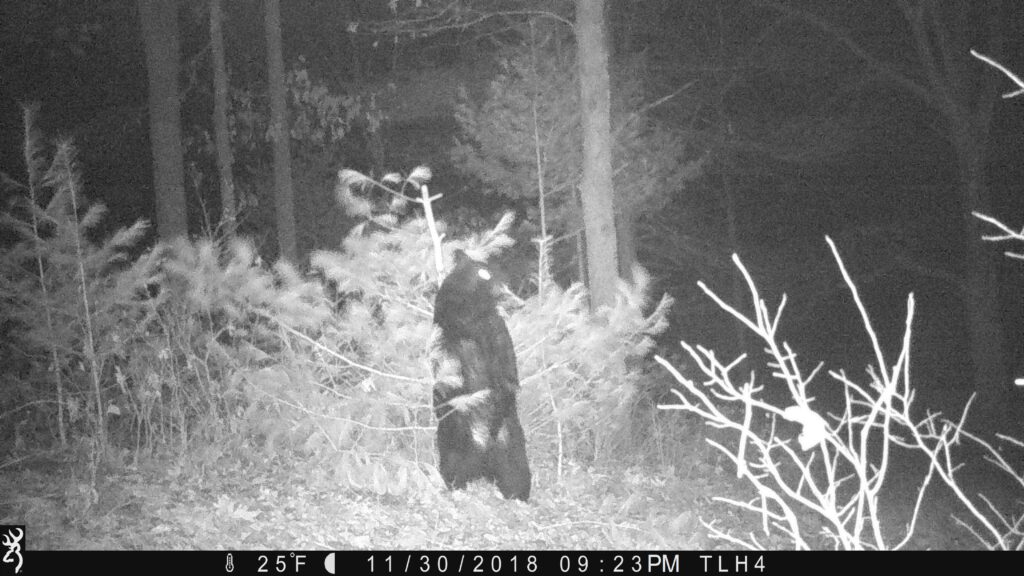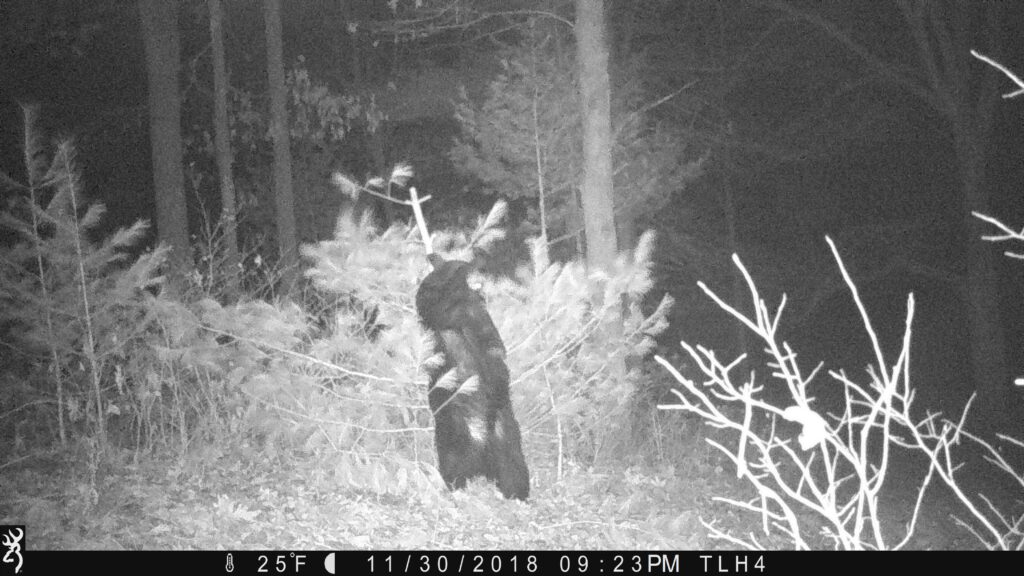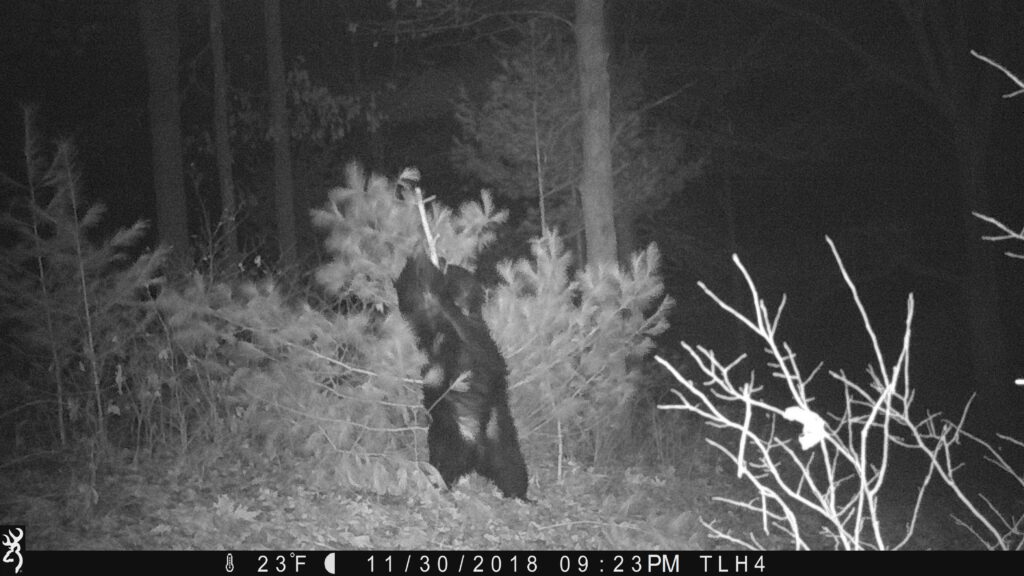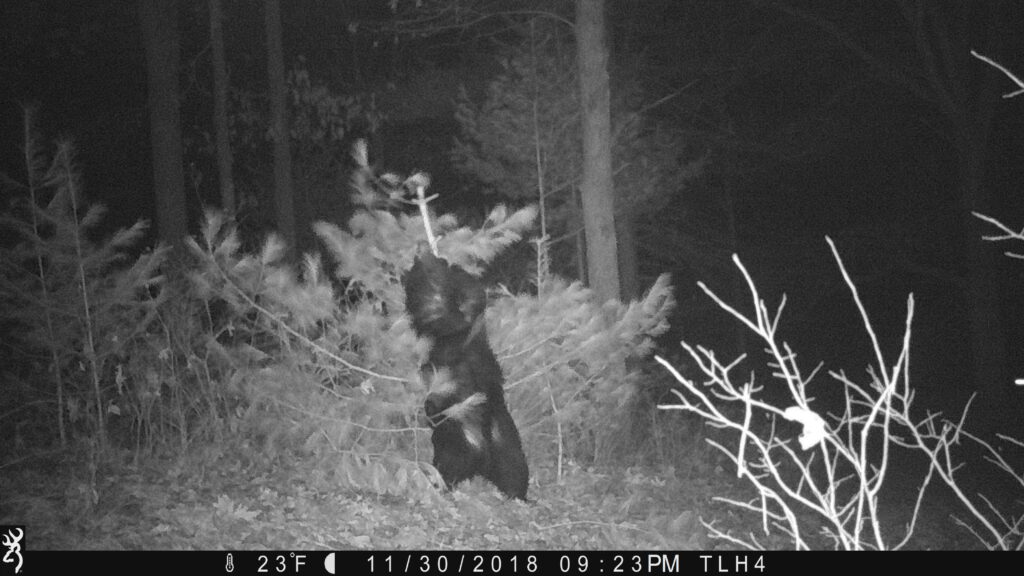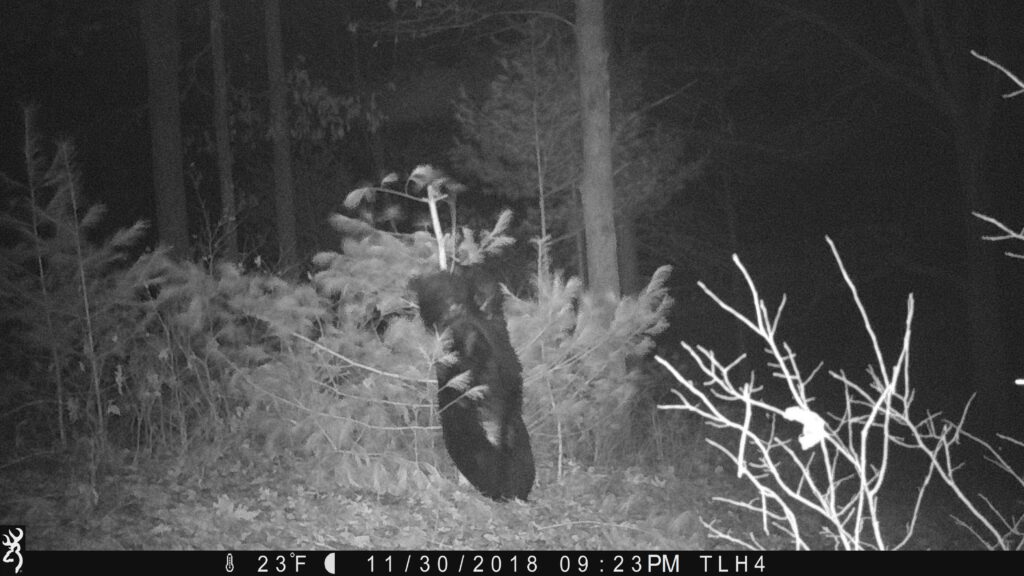Posts Tagged → season
Deer season mostly in the rearview mirror
All year we hunters wait for deer rifle season like excited little kids holding our breath for some big, special treat. And then rifle season arrives, we run ourselves ragged, and suddenly…a switch is thrown…it is all over.
Where did all our fun times and friends and family go? Why, they were sitting with us having dinner and laughing just minutes ago, and adventuring around the beautiful woods together just hours ago…and now…now my life seems so very quiet, and humdrum.
Like the three days of bear season, the two weeks of deer season are so highly anticipated, and yet they are also then over so, so quickly. I guess this is the way of all fun times.
This year I can’t think of any woods I hunted in that had many or any acorns. This absence of food literally caused mountain deer to migrate. It was wild to see, or not see, as the word “see” can be taken to mean, because we hardly saw many deer in the mountains. Sure, we took some, and I have no complaints, as I know plenty of people who did not even get a shot at a deer, much less see any. I was able to pick and choose some shots, and one that I declined on a very nice buck I regretted soon after. That shot was not a “good” shot, but would have hit him right in the middle of the ribs. A liver shot, and almost immediately fatal. But a tracking job nonetheless, and not a shot I would have been proud of.
And so that buck lived to see another day, and because I had not filled my buck tag in 2019, I felt both very grown up for having made the correct decision and also very foolish for having not taken what was given to me.
But the mountain hunters did not have a lot of luck in rifle season, the best hunting having happened in October and early November during archery season. Plenty of browse and some few acorns were available for the deer then, and they were not feeling so pressured and anxious about food as they are now. No, the mountain hunters sat and waited, or did drives and yet still waited to see deer. But the deer, desiring not to starve to death, migrated on to whatever food sources they could find, and there they still sit.
Well, the fact is that the north country is seriously socked in with deep snow. Like a solid two to almost three feet in most places. The deer can hardly move through this, let alone paw or browse for food under it. Additionally, as soon as warm temperatures arrive, or a few hours of rain, that deep snow will have a thick, hard crust on top of it. And the deer will not be able to walk on it, stand on it, feed on it. Like we had in 2005, we will probably see a serious deer die-off across big parts of the Big Woods north country from this deep snow in the coming week. In 2005, after a similar deep snow with a heavy crust, I recall finding dozens of deer carcasses all over the mountains around us. In some instances the coyotes were able to close the distance and just pull them down, but in a lot of situations, the deer just laid down on that crusty snow, curled up, and starved to death.
Pretty sad, even for conservationists who know the mountain deer herds needed to be thinned out for the sake of forest health.
Down in the farmland, the deer seemed to be doing just dandy. In farm country, edge habitat browse and waste grain are so abundant that the plague of four-legged deer locusts have no trouble making a living, deep snow or not. Flintlock season cannot come too soon for the farm country, where our own tenant farmer informed me a few weeks ago that the deer have eaten all of our profit to the point where we can no longer afford to grow corn or soybeans. Going forward, we will only be growing hay.
For hunters having trouble understanding what this means, let me explain. If the farmer cannot make money from farming because the over-abundant deer eat up his profits, then the farmer cannot afford to pay the land owner a healthy per-acre rent that pays the land taxes and covers many annual maintenance costs. If farming won’t pay the costs of farm land, then maybe a few house lots here or there will pay…and thus is beautiful, sacred farmland slowly, inexorably, sadly converted to pavement. By deer no less.
And so in farm country, deer managers like me see deer more like rats than like deer. Rats are vermin, the overabundant deer become vermin, and deer hunting becomes less of an adventure, and more of a chore, or a jihad, to protect the beautiful landscape from becoming one more housing development.
These are some reflections on deer season. I have not killed a deer with a flintlock in many years, and hopefully this season I will. God knows, the farmland needs all the help it can get.
Halfway through PA deer season
We are halfway through deer season, and I, having hunted in several counties in Northcentral and southcentral Pennsylvania, have a few observations. These might be helpful to those seeking to fill tags this coming week, or to policy makers trying to mould a better season next year.
a) Despite the “purple paint law,” which is Pennsylvania’s new private land trespass law that carries severe penalties for trespassing, PA hunters continue to trespass and poach and shoot deer on private lands they have no business being on. So far this season I have been witness to the deliberate taking of deer on private land by people who have no right to hunt there, both a buck and a doe. One incident was just plain sloppy woodsmanship; the other was purposefully crafty. Some trespassers are habitual lawbreakers, who trespass more to get one over (in their warped thinking) on someone who has land, rather than to actually pursue a specific trophy animal or meat for their family. This blurs into the mental illness category. Others are defiant individuals, who have always had authority problems both at work and elsewhere. This also blurs into the mental disease category. The antidote to all this miserable behavior is the joy of hidden trail cameras, which have caught several malefactors in flagrante. Yeah, Jon, you….again. To be continued!
b) Pennsylvania is now a huge deer trophy destination. The trophy bucks that are being taken from archery season, when deer are at their most vulnerable, right through rifle season, would have been unimaginable twenty or forty years ago. The enormous heads (antlers/ racks scoring 140 inches and above) that are being taken by hunters everywhere across the state are easily on par with famous trophy destination states like Illinois, Iowa, Michigan, and Kansas.
This development is a looooong way from the spike bucks and “trophy” fork horns of my youth, and frankly to which too many older hunters would gladly return.
This exciting development is primarily a result of top-notch deer management by the Pennsylvania Game Commission over the past twenty years. Along that twenty-year-way, PGC has suffered a lot of abuse for its deer management, which always involved reducing the number of over-abundant does and retaining a high number of mature bucks to return again next year, with racks that have gone from OK to spectacular. People upset with PGC were long accustomed to “seeing” lots of deer. These people incorrectly equated overabundant deer with a healthy deer population, because, in fact, the truth is the opposite. Too many deer is unhealthy for not only deer, but for a boatload of other animals, and plants, that everybody other than deer needs. Deer diseases like TB and CWD are a result of deer populations too high for their own good. So is the deer-car-collision disease, which is crazy high in PA.
We have to kill a lot more deer. PGC knew that and started it in 2000, and it was a slow and painful process that necessitated an entire cultural shift among tradition-bound hunters.
However, PGC alone doesn’t get all the credit for these big bucks, even though the agency has carried the torch of scientific wildlife management through a hailstorm of undeserved crap. Another reason Pennsylvania has so many massive trophy bucks roaming around is that we have a lot fewer hunters and less hunting pressure over the past five years, and over the past fifty years. There is a big difference between someone who buys a hunting license, because he has been proudly buying a license every year since 1962, as it is part of his personal identity, and someone who buys a hunting license with the intention of squeezing out many of its benefits and opportunities, such as climbing high into remote places in pursuit of huge bucks.
Buying a hunting license is a tradition among many older Pennsylvanians, even if they don’t actually hunt much or at all with it.
If I can think off-hand of five hunters I know who will comment on the dearth of deer hunters seen in the more remote places, I can probably easily find five hundred others who will testify to far less hunting pressure in most places, not just the remote ones. This means that old bucks with big trophy racks have more secret places to go where they can go on growing old, without dying of sudden acute lead poisoning from a hunter standing downwind behind a tree. As the population of really older bucks continues to climb, they begin to spill out into more accessible and less topographically challenged places, where the average Hunter Joes can now occasionally pick one off for the local newspaper’s front page.
c) I miss John R. Johnson as my long time knife maker of choice. John took a break from making his beautiful custom knives about five years ago, and fortunate are those of us who bought his highest-quality products while we could. While it is possible to hunt with a hunk of basic soft steel half-assedly made into a rough knife shape in China, why should we? Ever since the dawn of our species, a hunter-gatherer species, our hunters have ALWAYS prided themselves on the high quality of their weapons and accoutrements. Having a nice rifle and a nice knife is a source of great pleasure for every hunter I know, and most aspire to having the best they can stretch to afford. That is to their individual credit and to our collective credit, as a sign of sophistication and high performance. So if you are fortunate enough to find a JRJ hunting knife somewhere, buy it right away. Cherish it, keep it sharp and well, and use it. It is a product of one of our central Pennsylvania native sons, and a true embodiment of the rugged character and values we here in central Pennsylvania cherish.
Reflections on 2020 bear season
As if by magic or just the batting of an eyelid, the much anticipated 2020 bear season is now behind us, having concluded at dark yesterday. Sad to see our friends go; we had such a fun time! The last of our bear hunting guests have left, cleanup has commenced, preparations are under way for Thanksgiving, and there are some reflections to be had on bear season.
First, where the hell were the bears? Serious question here. We hunt in a mountainous Northcentral area that is Pennsylvania’s “Bear Central.” And despite us daily scouring a lot of remote, very rugged territory that is usually home to lots of bears, we saw neither bears nor bear poop. None. It could be the warm weather has bears hunkered down under cool overhangs in even more remote places. It could be the low acorn crop has bears going in to hibernation early, because there is no more food for them to eat to put on the extra fat they need to hibernate successfully. The truth is, no bear tracks or poops have been seen around here for months, which is remarkable. I cannot think of any year prior like this.
Second, where were all the hunters? We heard only a few shots between Saturday and Sunday, and either none or one on Monday, and for sure none on Tuesday; and very few hunting parties were on the radio on any day. This means that few large scale hunting drives were going on. Without hunters moving across the landscape, the bears don’t have to move out of their way. They can just sit still and not run the risk of exposing their rib cage to a hunter’s bullet. That means that the bears can loaf about in some remote corner, escaping the unseasonable warmth or just waiting for the wafting human scent to drift away before making their usual rounds again. Which means the few hunters who are out don’t see much action.
Third, where were all the other critters, like turkeys and deer? Like with bears, we saw very little deer or turkey poop in the woods. And although I myself saw two whopper bucks and a five-point up close, no one else saw any deer. Nor did any of us see any turkeys. Once again, the absence of these otherwise ubiquitous animals could be due to the relative absence of acorns. Which would push the wildlife far afield to find food sources.
Fourth, despite all of our hunting setbacks, did any of us care a bit? No! We missed all of our friends who could not be with us for various reasons, like fear of the CCP virus, or family emergencies requiring them to stay at home. But those of us who gathered had a lot of fun nonetheless. And with or without a bear on the game pole, we would not have missed this time together for any reason at all. We caught up on our families, our work, our homes, cars, friendships, wives, and politics (yeah, there was a lot of pro-Trump politics). Some people drank way too much alcohol, and we got some great pictures of it all, like the one guy asleep on the cold ground outside. No, we don’t post those here. We ate like kings, that is for sure, and no one lacked for food or drink.
Finally, it is possible that the new early bears seasons (archery, muzzleloader, and special junior+ senior rifle) are removing so many bears from the woods that come rifle season, very few huntable bears remain to be had. According to real-time hunting harvest data posted at the PA Game Commission website, more bears were killed in the early seasons than in the official rifle season this year. This means there are fewer bears available for the rifle hunters. It is possible that many hunters expected this, based on last year’s harvest patterns, and they stayed home or hunted alone, instead of joining the big crew at camp, like usual. As of late today, just 3,138 bears had been killed total this year. That is about a thousand fewer than expected.
Based on this raw data alone, the early bear seasons are actually backfiring. They are not removing the high surplus number of bears that are beyond Pennsylvania’s social carrying capacity. Rather, the early bear seasons are removing the easiest bears and leaving few to be hunted in the later rifle season.
And this new dynamic could be the real story in PA’s bear season: There are so many early season bear hunting opportunities for individuals that they collectively take the wind out of the sails for the regular season hunters, thereby having a boomerang effect on the entire thing and limiting it.
We won’t know what all this data really means for another few years, and by then either great or even fatal damage will have been done to Pennsylvania’s traditional bear camp culture, with its big gatherings and big drives and big camp camaraderie dying out, or we will simply all have to learn to adapt to new ways of hunting. I have to say, there is no substitute for men gathering at a camp to hunt together. The gathered hunting party is the most human of experiences; it is an institution as old as our species. Its purpose was not just making meat, but also social and sociological.
I sure hope these myriad new early bear seasons are not self-defeating, in that they do not kill that traditional bear camp culture by removing its whole purpose ahead of the game. Question for the PGC: What incentive is there to push your body hard through rugged and remote landscapes, destroying your boots, tearing your clothing, and often losing or breaking some of your gear, including damaging your gun, when the animal you are seeking has already been removed?
Below are some photos from one of our trail cameras two years ago. Just days after bear season ended, a bear was caught gloriously and most joyously rubbing its back against a young white pine tree. Almost like a pole dancer. Pretty hot hip shakes there. We haven’t seen a bear anywhere around here since May this year.
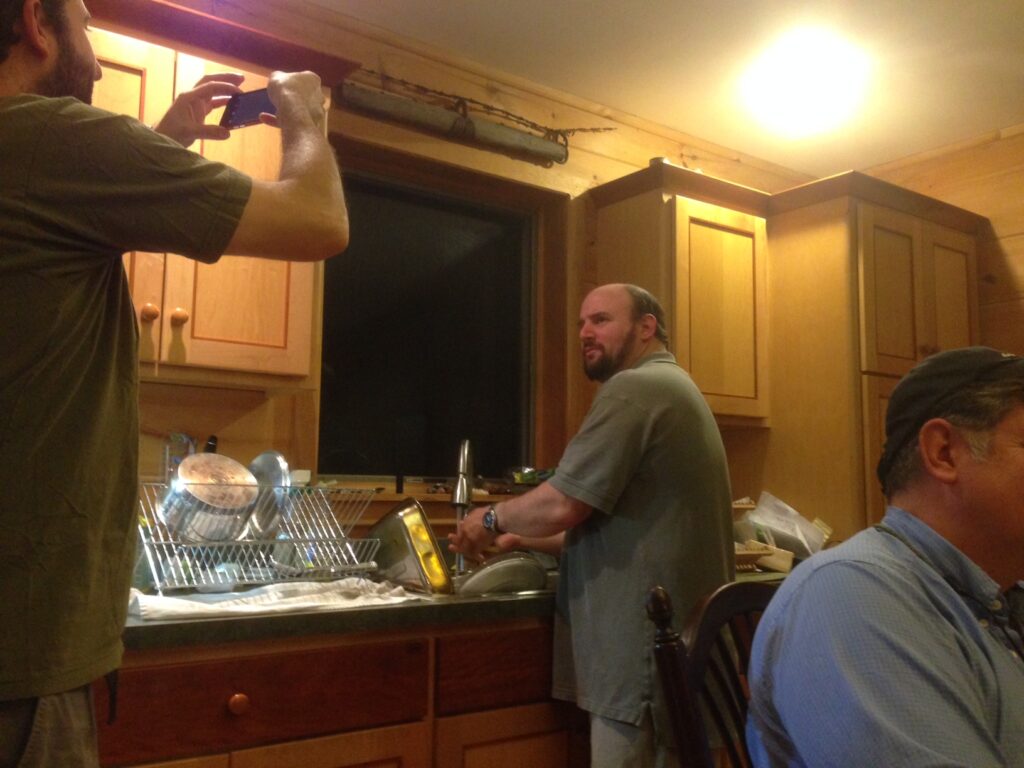
When one of our guys is finally browbeaten into washing dishes after years, it is cause for “Notify the media” acts like taking his unhappy picture. This is back in 2015. He still has to be browbeaten into washing the damned dishes

Lycoming County is the boot-looking shape in the northcentral area. Its northwestern corner is where we hunt. The darkest township there demonstrates the importance of organized hunting drives. A bunch of large hunting clubs are located in this area, and their members put on highly coordinated, obviously successful drives.
My comments to the PA Game Commission
The Pennsylvania Game Commission board of commissioners will be meeting this weekend, to set next season’s dates and bag limits. Like many other people, I submitted comments by email last week. From past experiences with this, I know that the commissioners read comments and requests from the public. Some of my comments, and those of my son, have received direct feedback from various members of the board.
A key to getting the commissioners to read and truly consider your comments is to submit them with plenty of time for the recipients to read them. If you submit comments a day or two before the meeting, it’s a very low likelihood of anyone having time to read them. Also, try to keep comments short, to the point, and sweet. Comments with prolonged bitching, whining, and playing biologist when you have no training or education or even a novice’s interest in wildlife biology, are all ways to ensure that your audience at best glances at your comments.
“Dear Commissioners,
Hunting should be fun, and therefore our small game seasons should run unbroken from their Fall opening to their February close. Whatever long gone reason for the on again-off again pattern of small game seasons, Pennsylvania must create opportunities for everyone. No biological reason exists for hiccup-style seasons. Few if any other states have this odd pattern. Let’s just let our hunters have fun and hunt.
In that vein, please consider allowing bodygrip traps on running pole sets in our most rural WMUs. The idea that a loose domestic dog is going to get caught in a trap in the middle of a state forest wilderness is preposterous. Same is true on private land. Same goes for allowing snares. We need all the tools we can get to manage coyotes. With now three years of crazy freeze-thaw-rain winter weather cycles, it’s impossible to rely on footholds. Cable restraints should be allowed throughout the whole season, and snares should be allowed on private land and or on public land in the Big Woods WMUs.
Finally, please put one of our Sundays on the day after the Saturday bear rifle opener, and another Sunday on the day after the Saturday deer rifle opener. This will create the most energy and excitement for our hunters. Even better, make bear and deer rifle concurrent!
Thank you for considering my thoughts,
–Josh”
Our Wildlife Management Comments Submitted to the PA Game Commission
Dear PGC Commissioners,
In so many ways the Game Commission is on an exciting path, really moving forward on policy, staff culture, and scientific wildlife management. It is an exciting time to be a hunter and trapper in the great state of Pennsylvania, thanks to you. Hunting and trapping are supposed to be fun, and the PGC should be able to maximize opportunities without sacrificing the natural resource base. If anything, the agency has been perhaps too conservative, too cautious. In that vein, here are some small suggestions for improving hunting and trapping in Pennsylvania:
a) Make all small game seasons concurrent, start them in late September or early October and run them unbroken until mid February. The current on-again-off-again schedule is silly, an artifact from many decades ago. Our current small game hunting schedule leaves kids and oldsters alike out in the cold with nothing to hunt if they can’t get to deer camp, or if they do kill a deer and want to keep on hunting. Hunters deserve maximum opportunities that do not degrade or put wildlife populations at risk, and adding a few extra days won’t hurt anything, but they will help hunters tremendously. Put another way, the risk of changing this is very low to non–existent, and the benefits are huge. Well, what is the risk, really?
b) Allow the use of snares in rural WMUs and/or on private lands. Cable restraints are an important trapping tool under any circumstances, and especially so as we experience ever-increasing freeze-thaw-freeze-thaw winters, with rain no less. These weird winter conditions render traditional footholds nearly useless both early and late in the season. Cable restraints can function better than footholds under those conditions, but they just are not sufficient for the big coyotes we are encountering. Getting coyotes into cable restraints is tough enough, and holding them there is even tougher. Chew-throughs of our cables are common, where a snare would positively catch the coyote and hold it, bringing it to hand and into the bag. In rural areas (or on private land) there is a far lower expectation or risk of a pet or feral dog or cat being caught. We are ceding too much to the anti-trappers by prohibiting snares where they can do the best good. A pet is an animal that lives in a home. Eliminating a very useful tool because of some vague or low-probability worry is not good policy. We can do better, and snares are much better than cable restraints in general, and particularly in the northern Big Woods areas. Also, CR certification can only be done right in person, through hands-on training. This online certification is going to lead to problems, especially where CRs are used like snares.
c) Allow the use of body-grip (Conibear) traps outside water courses, specifically on running-pole sets for fishers, bobcats, and raccoons. Like the snare situation above, our trapping regulations are unrealistic, they are too conservative, penalizing law-abiding trappers because of vague fears that under reasonable circumstances will not happen. Securing body-grip traps up off the ground is well out of the reach of dogs and domestic cats. Separately, if a pet owner lets their animal out the door to run free, where it can trespass, be hit by a car, be eaten by a coyote or fox or hawk, or get hurt in a fight with another animal, then they do not truly care about it and it is not a real “pet.” Pennsylvania trappers do not deserve to be hurt because of others’ irresponsible behavior. Elsewhere in America, the use of bodygrips on running pole sets is very effective and humane. We can stick with the #160 size as the maximum.
d) Extend the fisher trapping season and areas. Trappers in Berks and Lebanon Counties have told me of catching fishers in their sets, and we are seeing them in Dauphin County. There is no good reason why we cannot extend where and when we trap these abundant predators. Incidentally, they eat bobcats and turkeys, and it would be silly to expect fishers to simply harmoniously co-exist with other animals. They are a voracious predator and they will have a disproportionate impact on predator and prey populations alike if allowed to expand unchecked. Fishers are cool animals and I am all for having them in our ecosystems. What is lacking now are the mountain lions and wolves that in the distant past would have eaten them, and kept them in balance with other wildlife. We humans now fulfill the role of lions and wolves. Let us at ’em.
e) Make sure bobcat populations can sustain these long trapping and hunting seasons. We are seeing a lot less bobcat sign and fewer bobcats on our trail cameras. This was the first year we did not get a bobcat through either trapping or calling in 2G and 4C, and while this may be just our observation, we are concerned. If bobcat harvests must be reduced, then we prefer that it come out of their hunting season. There is a ton of hunting opportunities in Pennsylvania, and not a lot of great trapping opportunities. Heck, muskrats are practically extinct, coyotes have eaten most of the red fox in the southcentral, and possums are clogging nearly every trap. Let us keep our bobcat trapping intact.
f) Reinstate concurrent buck and doe deer hunting. We are seeing a high number of deer nearly every place we hunt (WMUs 2G, 4C, 3A, 5C, 5D). Deer populations are definitely lower than in 2001, and deer are harder to hunt now than then, but the quality is unbelievable, and the herd can sustain both doe and buck hunting. Pennsylvania is now a real trophy destination, so keep up the scientific management, which would include allowing hunting on Christmas Day.
g) Expand the bear season by one day in WMUs 2G and 4C, or rearrange the season entirely. There are an awful lot of bears everywhere, especially in 2G and 4C. On the Friday before bear season starts, we see loads of bears having tea and crumpets in the back yard. They are watching football and hanging out leisurely in reclining chairs. Come Opening Day through Wednesday, we might see the hind end of a bear or two, or we might occasionally harvest a bear, if we work hard enough. By deer season opening day the following week, the bears are back to having tea and crumpets in the back yard, hardly disturbed by all our hunting efforts. Another way to address this is to make bear and deer seasons concurrent, at least for one week, and perhaps start that concurrent season the week of Thanksgiving.
h) Do more to end wildlife feeding. We continue to see mangy bears, and deer baiting under the guise of “helping” wildlife through artificial feeding. It’s not good for the animals, and can actually be bad. People also feed wildlife to entice game animals away from (other) hunters. This is a cultural practice that PGC needs to do more to end, through education and enforcing the bear feeding regulation.
Thank you for considering our comments. We do love the PGC and admire your field staff, especially.
Josh and Isaac First (father and son)
Harrisburg, PA
Outdoor sports starting to ramp up now
Outdoor sports are well under way here in Pennsylvania. This is the “Christmas in October” season soo many of us dream about since the last hunting season ended months ago.
Archery season started a month ago, and the rut (primary breeding season) is now in full swing. That is evidenced by the “deer storms” that go crashing through the woods at any time of day or night now, as well as the increasing numbers of dead deer lying on the side of the roadways. Chasing is a main part of rut activity, and deer of both sexes will blindly run right out into the middle of a suburban lawn or a road as their hormones and instincts take over their better judgment.
Bowhunters take full advantage of that mindlessness, and they are now starting to really spend time on stand, trying to lure in the otherwise wary whopper trophy buck. Estrous doe pee is the number one deer lure, and it is what I use with very high success rates. One problem is that so many eager hunters jump the gun and start putting out doe pee, in huge quantities, too early in the season. A few drops on a tampon or cotton ball hung from a branch is all you need in early November.
Although furbearer trapping season started a week ago, the unseasonably warm weather has many people, myself included, holding off laying out steel until mid-November, when mink season starts. What is the point of catching a predator with patchy fur? The colder it gets, the more their fur fills in, the softer it becomes. The softer the fur, the more luxurious it feels. The better the fur, the happier I feel about spending late nights skinning, fleshing, and boarding pelts in the cold.
I will say this, however: Most of my predator trapping these days is aimed at reducing the over-abundant populations of skunks, opossums, and raccoons, all of which are voracious bird nest raiders. To my eye and ear, cute little birds are always entertaining and pretty to watch, and they deserve a chance to enjoy a comfy nest with a successful brood of hatchlings. Wild turkeys and grouse especially are vulnerable to these insatiable varmints that have few natural predators and a lot of suburban habitat in which to unnaturally propagate.
Having never sold a pelt, trapping is not a commercial or financial effort for me. Rather, it is the joy of being outside, being an integral part of the natural predator-prey chain, helping balance wildlife populations, and obtaining something useful, pretty, natural and biodegradable. The wild caught furs that adorn our home and cabin reflect the wild places we enjoy visiting, and the ancient skill set needed to catch these wary hunters.
Earlier this year a long time dear friend nastily chided me for hunting and trapping. Asking her how she could criticize me on the one hand, while on the other hand she regularly eats stone crabs (claws torn off of living crabs), other shellfish (taken from their cozy homes, jailed, then boiled alive), and all sorts of meats from suffering animals living on unsavory factory farms elicited no response at all.
This shallow, careless, hypocritical approach to life bothers me, but I doubt there is anything I can do about it, other than continue to live my own life well. Why or how people find pleasure from interfering in other people’s lives is a constant source of mystery. They get a sense of purpose, I suppose.
As a hunter and trapper, I am fulfilling a purpose that is as old as our species. The hunter-gatherer purpose is as old as humans, heck it is human, and is as old as the last ice sheets that covered the northern hemisphere. This lifestyle is eminently more natural than the artificial life of food from tin cans, huge monoculture “farms,” and sad feed lots that blot out habitat and wildlife, not to mention crushing the spirit of the animal.
Good luck this season. Enjoy living like a real human being, fellow hunters and trappers.
Good luck spring gobbler hunting tomorrow
Tomorrow is the spring gobbler hunting season opener here in PA.
People from all around PA and beyond are drawn to our forests and farm fields to try their hand at enticing a strutting long beard into shotgun range. It is probably the hardest form of hunting, because little is left to chance; nearly the entire process depends upon the lone hunter’s skills.
Those skills involve calling, sure, but they also involve understanding a turkey’s habits, its habitat, the local and larger terrain and topography, weather, and the impact of other predators, both human and four-legged on how a gobbler might respond to the seductive crooning of a the faux hen.
Turkey hunting is one of the least productive, most frustrating pastimes possible. And yet it is so popular.
Good luck out there tomorrow, ladies and gentlemen. Be safe (do not stalk turkey sounds), carefully shoot for the gobbler’s neck area between the head and the body, and enjoy the unfolding of springtime all around you as the dawn magically lights up the woods.
Seasonal weather changes are natural, welcome
Seasonal changes are natural tick-tocks on the world’s clock.
Following a natural cycle keeps us in tune with nature, even if the conditions aren’t always to our liking.
Cold arrived today.
Driving north on Friday, I photographed the “polar vortex” front as it closed in on central Pennsylvania. It was a dramatic sight, indeed, and heralded the coming of winter.
Right away, I spoke out loud to myself about the need to buy new knobby tires for the truck. A long, cold, snowy winter is ahead, and I need to be as prepared as possible. Winter isn’t too challenging, if I’ve prepared for it.
Tonight we got our first wood fire going, after cleaning out the wood stove and adding new fire bricks. About a cord of last year’s split oak remains before we begin burning the oak that Viv, Isaac and I split this past spring. By the time we burn through the left over wood, the new wood should be completely dry. We will burn between three and four-and-a-half cords this winter at home.
Wood is a natural, sustainable, renewable heat source whose carbon is part of the planet’s natural cycle. We plant a lot of trees, and they absorb carbon to grow big. It’s a closed loop, which is appealing.
Living life according to the planet’s rhythms is natural and healthy. Will you get cold? Sure. That’s part of living. And if you think it’s cold here, check out Minnesota or Wisconsin or Idaho. Not to mention Alaska.
Just put on long undies and get some Filson wool jackets and vests. You might end up enjoying the cold weather. I certainly do.
It’s duck season! No it’s turkey season! No it’s rabbit season!
In addition to picking apples with the family, one of Fall’s greatest attributes is the abundance of hunting opportunities.
A friend sent me a photo of a huge buck he arrowed last week. I am jealous of him because I have not yet had an opportunity to go bow hunt for deer.
Instead, I have been small game hunting, wild turkey hunting, duck hunting, and trapping.
So, it is not as if I have been missing out on the outdoor experience by failing to bow hunt. The problem is that I’m in a frenetic whirlwind of other, related recreational pursuits, because Pennsylvania is blessed with an abundance of wildlife and healthy natural habitat.
Spending time with my kids and friends outside in this environment is one of the healthiest, safest, most wholesome activities anyone can do. Hunting is safer than cheerleading, high school football, soccer, and baseball. It gets my son’s face out of whatever handheld device is sucking out his brain at any given moment.
Successful or not, time afield is the best family time possible.
Here are some old favorite cartoons about hunting, and most important is the Duck Season, Rabbit Season, Duck Season! episode.
Hunting season preparations – Xmas in July
Though hunting seasons may be many months away, the truth is that hundreds of thousands of Pennsylvania hunters are quietly sorting out their plans far ahead of time. Doe tags, DMAP tags, licenses and berths in a Quebec hunting camp for black bear and caribou, a camping permit for an ADK wilderness…it is all lining up now across the state.
Summertime preparations for Fall and wintertime hunting activities are a sign that yet another round of sustainable, renewable economic development is upon us here. After all, hunting is a $2.8 billion industry (or business sector, or economic sector) in Pennsylvania. Hunters are a renewable, and sustainable source of income and economic activity, so long as they have places to hunt.
Longingly fondling old, trusted firearms and bows, sighting them in on the sitting room wall or at the range, hunters can already smell that clean air, feel that cool breeze upon the cheek, and hear dead leaves rustle under foot, if they but close their eyes and imagine it.
It is Christmas in July now, as hunters across the Commonwealth gear up, trim up, and make sure everything is in order for that best time of the year: Hunting season.
